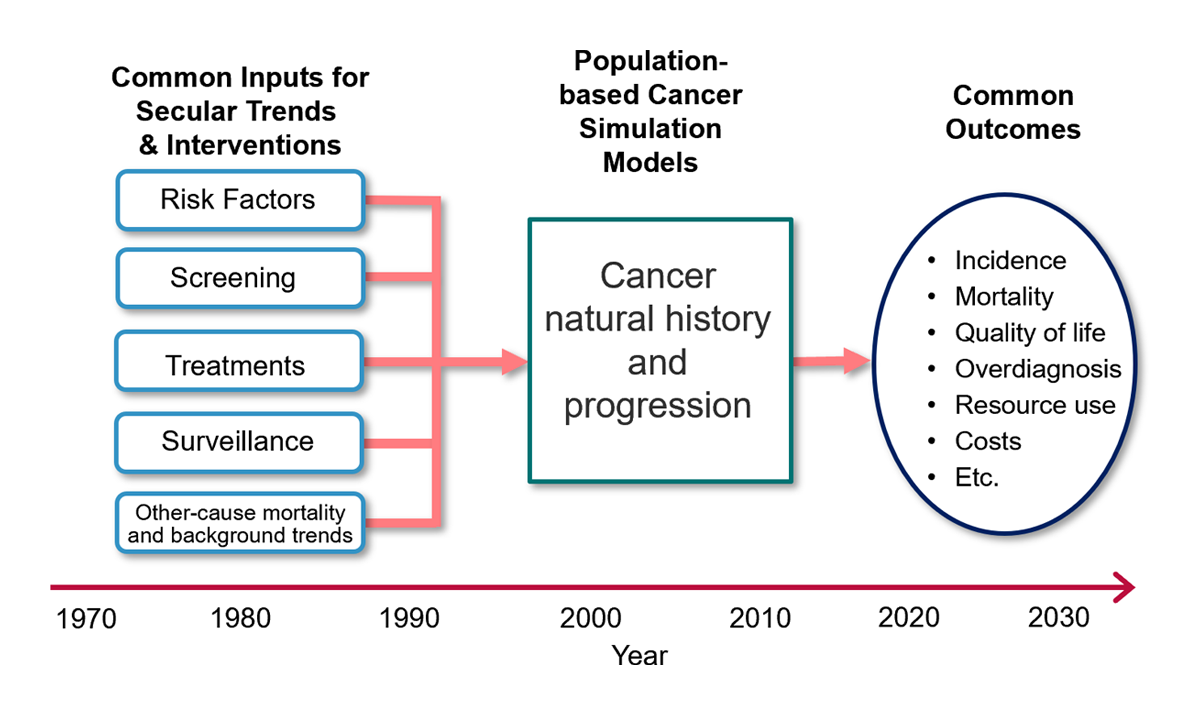Modeling Approach
A major accomplishment of CISNET has been to build an infrastructure for the comparative analysis of population-based models to answer important policy-based questions.
CISNET's flexible broad-based disease models incorporate unique central cancer natural history models, each formulated as an analytic or simulation model. Overlaying these natural history models are inputs that describe full range of cancer control interventions (i.e., changing risk factor profiles of the population, screening modalities, treatment regimens and surveillance for recurrence). Model outputs can include the full range of the benefits and costs of the interventions.
General Formulation of CISNET Models

General formulation of CISNET models that can handle the full range of intervention inputs.
Inputs to the models can include population demographics, the full range of cancer control interventions (e.g., prevention opportunities, screening tests, treatment regimens and surveillance protocols), and observed cancer outcomes (e.g., cancer incidence or mortality observed in a clinical trial or population registry). The modeled setting may be for a single hypothetical cohort or a range of birth cohorts of the U.S. population. This latter setting captures a range of birth cohorts and possibly changing risk factor and background health profiles, screening behaviors, and treatments used by each cohort as it ages. After estimating model parameters using observed data on cancer outcomes, the model can be used to study the impacts of interventions in the actual U.S. population. Recent developments have shown that multi-cohort cost-effectiveness models have advantages over single hypothetical cohorts in representing actual population dynamics over time. Outputs can include the full range of the benefits, harms and costs of the interventions.
Modeling the Natural History of Cancer
Because the preclinical natural history of cancer is largely unknown (since latent cancer is unobservable and detected cancer is generally treated), it can only be inferred using indirect evidence. Each CISNET model makes different assumptions about the process of carcinogenesis based on data from autopsy studies; prevention, screening, and treatment trials; cohort studies; cancer registries; and other types of studies. The assumed processes are nearly always parameterized, and model parameters are estimated using empirical data inputs and statistical algorithms.
Figure 2 illustrates an exemplar natural history model of colorectal cancer that includes the progression from adenoma to carcinoma. Risk factors can modify the onset and progression rates of adenomas, screening can detect (and potentially remove) pre-cancerous lesions and pre-clinical cancer, and treatment can alter post-diagnosis survival rates. Flexible models of this type can be easily adapted to incorporate new technologies as they are developed. For example, when CT colonography (sometimes known as virtual colonoscopy) became a viable alternative to optical colonoscopy, CISNET models were adapted to evaluate this new technology.
Figure 2: Example of a colorectal microsimulation model, including a natural history module that can be altered by interventions.
Colorectal Microsimulation

Example of a colorectal microsimulation, including a natural history model that can be altered by interventions.
To read high-level summaries or more technical information about CISNET models, visit CISNET Model Documentation.